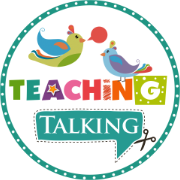
Starting Speech Therapy Notebooks Made Quick and Easy
October 08, 2016 3 min read
Starting Speech Therapy Notebooks is New to Me…What is the best way to get set up?
Starting Speech Therapy notebooks can seem daunting, but it doesn’t have to be! Here we will show you how to set up notebooks with your students in a way that leaves you calm and organized for the year ahead.

Interactive Notebooks for SLPs are some of our most popular printable downloads here at Teaching Talking. Today we are going to walk you through the basics of getting started with this super useful tool.
If you haven’t tried them yet, be sure to download your free printables from the links below. Choose from;
Choosing an Interactive Notebook Style
There are multiple options for the “base” of your interactive notebook:

All options have pros and cons. We asked experienced SLP and notebook user, Truvine Walker to tell us about her experiences;
“I have tried binders – both 3-prong and 2-pocket folders – and spiral notebooks. After experimenting with all 3, I consistently use spiral notebooks because they are the most efficient and economical choice for me. However, if I had an unlimited budget, binders would be my first choice.”
Here is a summary of the various options available to help you in your decisions!
| Base Product | Pros | Cons |
|---|---|---|
Binders |
|
|
3-prong, 2 pocket folders |
|
|
Spiral notebooks |
|
|
Composition Notebooks |
|
|
Covers for Interactive Notebooks
Students like to customize their notebook with their very own cover. For instance, if you’re starting speech therapy notebooks at the beginning of the year, you might choose the cover below from our Fall Language Notebook:

Tabs and Dividers for Interactive Notebooks
It can be useful to create sections in your notebook. A great example of this is when you are working with students with articulation needs who have multiple sounds in error. It can be very useful to use a tab to easily access a particular sound page. Similarly when working with students with phonological disorders using a cyclical approach – simply add some tabs to section off the notebooks.

I have made 2 FREE Divider Tabs packets that correspond with the sounds and goals in my Articulation and Language Notebooks. They are available using the links below:
Interactive notebooks work well for mixed groups. Your students may be working on both language and articulation goals within one notebook. Using tabs or dividers makes it quick and easy to access the current goal or to go back and review a previous target.

In our next post we are going to walk you through the benefits of introducing notebooks to your Speech Room. Don’t miss it, there are some surprising advantages I’m sure you haven’t thought of!
What are Speech Therapy Notebook Benefits? Find Out Here!
Learn even more about Interactive Notebooks by clicking the links below:
Speech Therapy Notebooks FAQs for Speech Pathologists
For even more tips & ideas for starting Speech Therapy notebooks, check out this Quick Start Pack at my TpT store!
Subscribe
Sign up to get the latest on sales, new releases and more …




